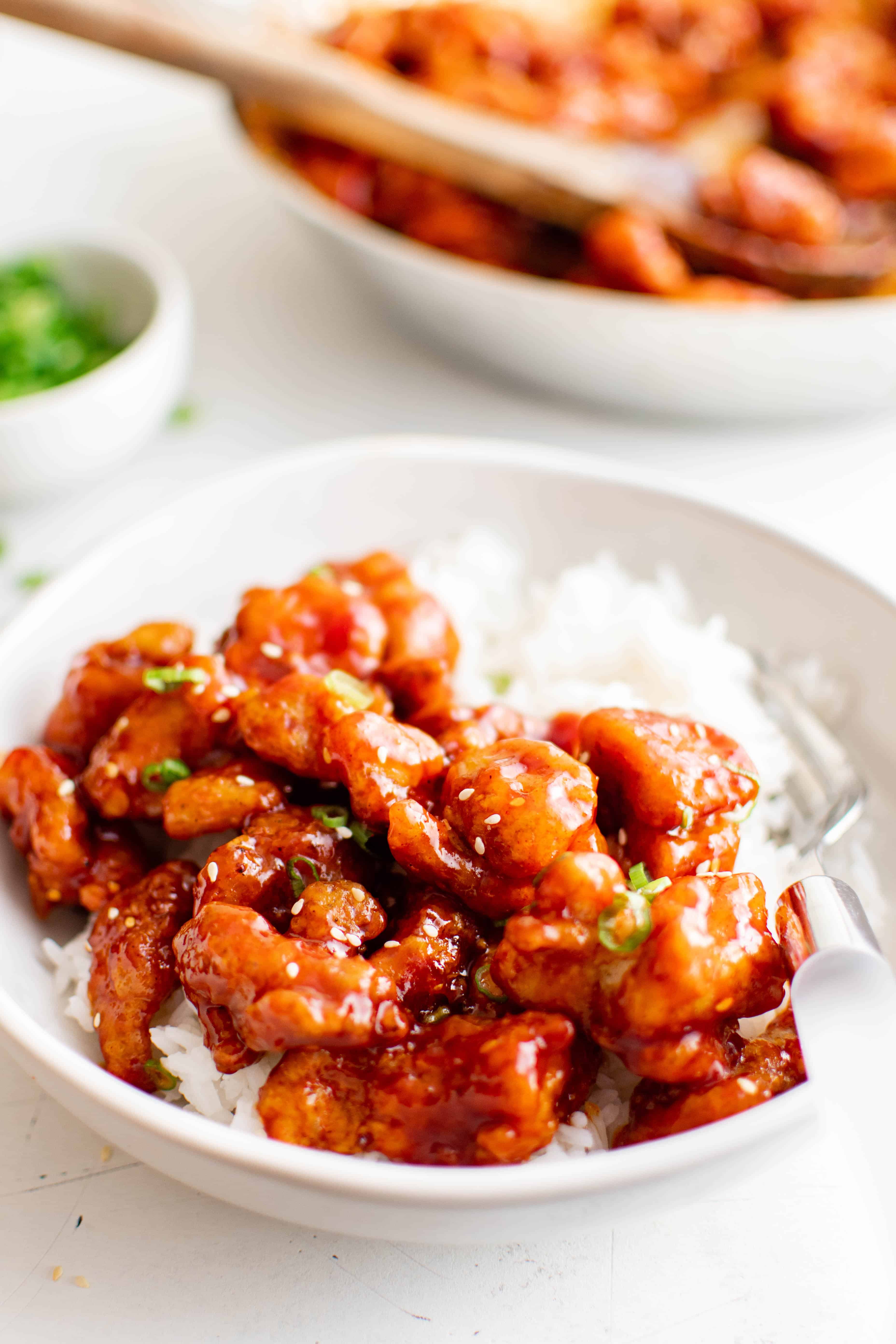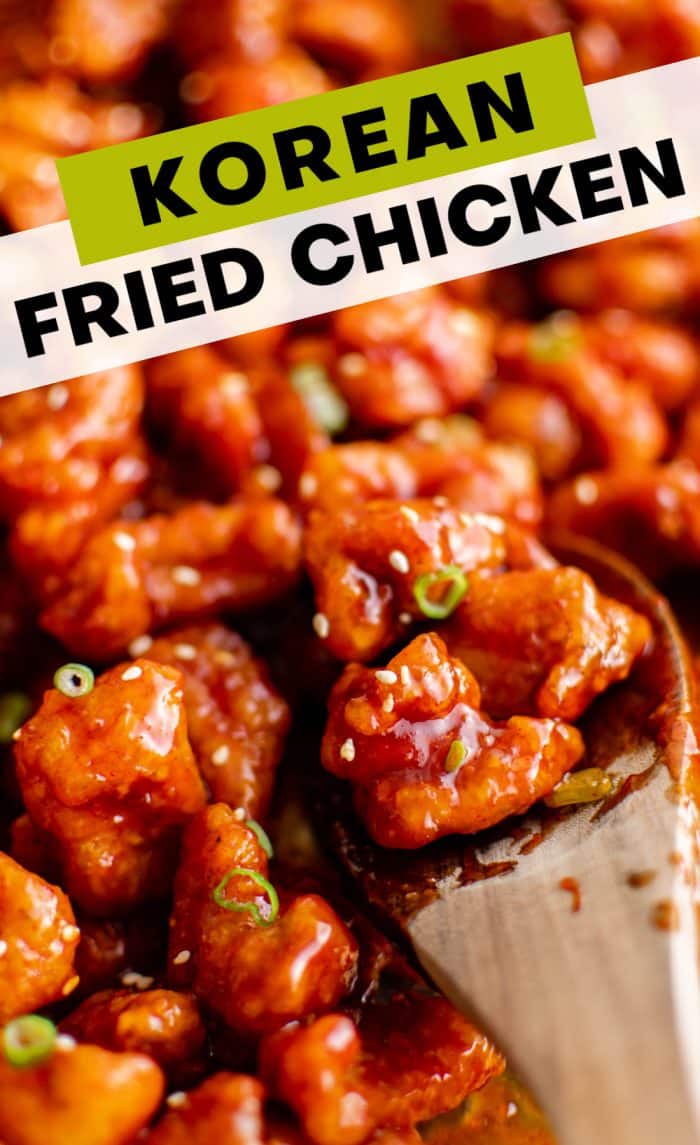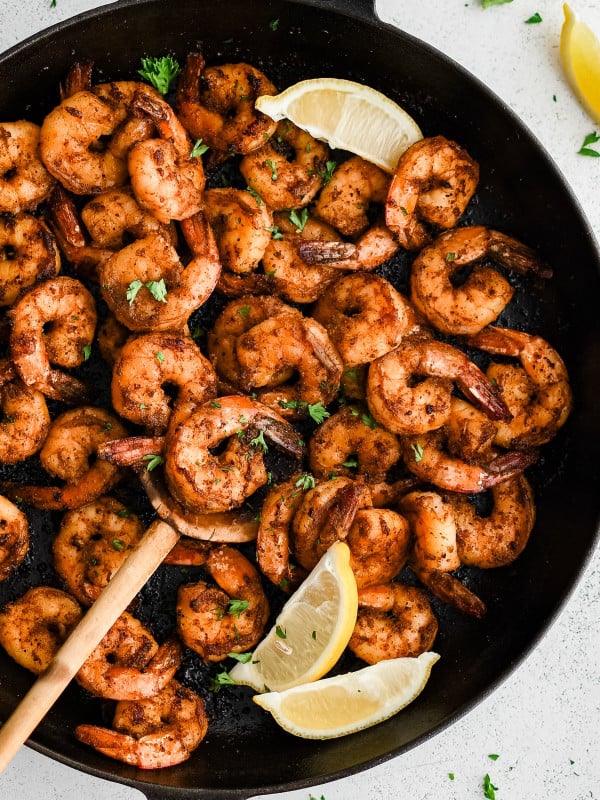This post may contain affiliate links. Please read our disclosure policy.
This Korean Fried Chicken is made with crispy fried chicken pieces smothered in a Korean-inspired sweet and spicy gochujang chili sauce. Also called Yangnyeom chicken, or “seasoned chicken,” this crispy, crunchy Korean fried chicken recipe is easy to make and delicious with a side of rice noodles or steamed rice.

Crackly bite-size pieces of fried chicken coated in a mouthwatering sweet and spicy gochujang chili sauce – you guys, this Korean fried chicken recipe is so so yummy and so easy to make!
Quick tip! If you’re new to deep-frying, check out my post, Deep Frying 101 where I share all my tips and tricks!
Table of Contents
What is Korean Fried Chicken?
Korean fried chicken, usually called chikin in Korea, is a term used to refer to a handful of fried chicken dishes originating in South Korea. Examples include basic huraideu-chicken (“fried chicken”) and spicy yangnyeom chicken (“seasoned chicken”). Influenced by Americans stationed in Korea in the 1940s, Korean fried chicken is different from American fried chicken. Rather than having a thick outer crust, Korean chicken has a thin and crackly crust. In South Korea, it is often enjoyed while drinking alcohol (anju) but is also popular as a main dish or appetizer.
What is Gochujang?
Gochujang is a red chili paste popular in Korean cooking. Savory, sweet, and spicy, gochujang is made from gochu-garu (chili powder), meju powder (fermented soybean powder), glutinous rice, yeotgireum (barley malt powder), and salt. Gochujang paste ranges from mild to extremely hot and may make a dish taste sweeter, smokier, or spicier.
Recipe Tips
- Potato starch gives Korean fried chicken its signature light and crispy crust. Substituting with regular flour is not recommended.
- The crunchy crust will turn soggy once it’s coated in sauce. For this reason, it’s best to serve and enjoy your chicken immediately after it’s been combined with sauce – unless you prefer your crust to be a little soggy.
- Gochujang paste can be very spicy – especially if you’re sensitive to spicy foods – so add half a tablespoon at a time until it reaches your desired heat level.
- Fry the chicken in batches. If you add too many pieces of chicken at once, it will lower the temperature of the cooking oil and crowd the pot, resulting in uneven cooking.
- Avoid making this recipe using chicken breast. Chicken breast meat is too lean and prone to drying out.

Double-Frying Makes Extra Crispy Chicken
Korean fried chicken is known for its thin, crispy, and crackly outer crust. The process works by frying the chicken just until the chicken starts to crisp. It is then removed, set aside, and allowed to rest for several minutes before being fried a second time until it is completely cooked and golden.
This double-frying method is especially important when frying chicken pieces with skin (chicken wings, drumsticks, etc). Chicken skin is mostly made of fat and water. When fried, the moisture in the skin starts to evaporate. Unfortunately, leaving the chicken in the oil until the moisture completely evaporates and is perfectly crispy will take too long, resulting in overcooked chicken. This is where double-frying comes in. Allowing the chicken to rest and cool before frying for a second time allows for additional evaporation before returning to the pot to fry for a second time.


Korean Fried Chicken Recipe
Ingredients
- 3 pounds boneless chicken thighs, cut into 1-inch cubes
- 2 tablespoon minced garlic, divided
- 2 teaspoon ground ginger, divided
- 1 teaspoon salt
- ½ teaspoon ground black pepper
- 2 cups potato starch
- 1 teaspoon garlic powder
- 1 teaspoon onion powder
- Vegetable oil for frying
- ⅓ cup low-sodium soy sauce
- ¼ cup ketchup
- ¼ cup light corn syrup, or 2 tablespoons of honey
- ¼ cup brown sugar, packed
- 3 tablespoon gochujang paste, see notes
- 1 tablespoon rice wine vinegar
Instructions
- In a large bowl mix the chicken with one tablespoon of minced garlic, one teaspoon of ground ginger, one teaspoon of salt, and ½ a teaspoon of black pepper. Cover and marinate for 30 minutes at room temperature.
- Mix together 2 cups of potato starch with 1 teaspoon garlic powder and 1 teaspoon onion powder in a large mixing bowl.
- Coat each piece of chicken in the starch mixture and transfer the chicken to a wire cooling rack to rest.
- Preheat a large frying pan or Dutch oven with 3 inches of vegetable oil to 350℉. Use a digital oil thermometer for accurate temperature reading.
- Carefully place a few pieces of chicken into the hot oil – make sure not to overcrowd the pot. Fry for a few minutes or until each piece is crispy.
- Transfer to a cooling rack set on top of a large baking pan to drain any excess oil. Repeat this process, making sure to reheat the oil to 350 degrees for 2-3 minutes before continuing the cooking process with the remaining chicken. Note: The chicken will not be fully cooked or crispy at this point – that’s ok. We will be
- Once all of the chicken has been fried and transferred to the wire rack, increase the oil temperature to 375°F (190°C).
- Refry all of the chicken pieces in batches of 5-6 pieces for 2-3 more minutes or until fully crispy and golden brown. Repeat until all of the chicken has been fried for a second time.
- Let the chicken sit for a minute or two after the second fry. This ensures it stays extra crispy even after being tossed in sauce.
- In the meantime, mix the soy sauce, ketchup, corn syrup, brown sugar, gochujang paste, vinegar, and the remaining minced garlic and ground ginger together in a large skillet set over medium heat. Let it come to a simmer, stirring continuously for 5-6 minutes or until thickened and glossy.
- Carefully toss the chicken with the sauce until all of the chicken pieces are coated. Cook for an additional 3 minutes.
- Serve garnished with chopped green onions and sesame seeds, if desired.
Notes
- Gochujang paste can be very spicy – especially if you’re sensitive to spicy foods – so add half a tablespoon at a time until it reaches your desired heat level.
- Leftovers: Store leftovers in an airtight container in the refrigerator for up to 3–4 days. Line the container with a paper towel to help absorb moisture and preserve crispness.
- Freezing: For longer storage, freeze the fried (unsauced) chicken pieces on a baking sheet until solid, then transfer to a freezer-safe bag or container. Freeze for up to 2 months. Do not freeze chicken that’s already sauced—it will turn soggy when reheated.
- Reheating (without sauce): Reheat in a 375°F air fryer for 3-5 minutes, or place the chicken on a wire rack set over a baking sheet and reheat in a 400°F oven for 10-12 minutes.
- Reheating (with sauce): Add the chicken to a nonstick skillet over low heat. Cover and warm slowly, stirring occasionally. Add a splash of water or extra sauce if needed to loosen the glaze.
Nutrition
Nutrition information is automatically calculated, so should only be used as an approximation.
How to Make Korean Fried Chicken with Step-By-Step Images


Step 1: Add the chicken pieces to a large bowl with 1 tablespoon of minced garlic, 1 teaspoon of ground ginger, 1 teaspoon of salt, and 1/2 teaspoon of black pepper. This is where the flavor for your chicken starts.
Step 2: Use your hands or tongs to thoroughly combine the chicken with the seasonings. Let it sit for at least 15 minutes (up to 30 minutes) at room temperature to soak up all the aromatics.


Step 3: In a wide, shallow bowl, mix together the potato starch with garlic powder and onion powder. This seasoned starch is the key to that ultra-light, shatteringly crispy crust that defines Korean fried chicken.
Step 4: Place a few marinated chicken pieces into the starch mixture, gently pressing them into the coating. Work in batches to avoid clumping and to ensure even coverage.


Step 5: Toss and press each piece in the potato starch until fully coated and no pink chicken is visible.
Step 6: Transfer the coated chicken to a wire rack set over a baking sheet. Let it rest for 10–15 minutes. This helps the starch hydrate slightly and stick better during frying, reducing the risk of the coating falling off.


Step 7: In a skillet or saucepan, add soy sauce, ketchup, corn syrup (or honey), brown sugar, gochujang, rice wine vinegar, garlic, and ginger.
Step 8: Simmer the sauce over medium-low heat for 5–7 minutes until it thickens slightly and turns glossy. Stir occasionally to prevent burning. Once ready, remove from heat.


Step 9: Fill a heavy-bottomed pot with about 2 inches of vegetable oil and heat to 350°F. Use a thermometer for best accuracy. This is the ideal temperature for the first fry.
Step 10: Fry the chicken in batches for 4–5 minutes until just cooked and lightly golden. Transfer back to the wire rack to drain and rest. The chicken will be fried again for ultimate crispiness.


Step 11: Increase the oil temperature to 375°F (190°C). Fry the chicken a second time for 2–3 minutes until deep golden and super crispy. Drain again on a clean wire rack.
Step 12: Let the chicken sit for a minute or two after the second fry. This ensures it stays extra crispy even after being tossed in sauce. As the chicken rests, gently reheat the sauce over low heat, then remove from the heat.


Step 13: Add the freshly double-fried chicken to the pan of warm sauce. Make sure the heat is off or very low to avoid sogginess or burning the glaze.
Step 14: Gently toss the chicken in the sauce until each piece is evenly coated and glossy. Serve immediately with rice, pickled radish, or cold beer. Garnish with green onions or sesame seeds if desired.
How to Serve
Pickled radish and beer are often served with “seasoned” Korean fried chicken, but I prefer this dish with a side of sticky White Rice and a light vinegary cucumber salad. It can also be served with rice noodles or mixed greens. It’s also really good with dipping sauces like this sweet and tangy Korean BBQ Sauce or Spicy Gochujang Mayo.
Craving more Korean-inspired take-out recipes? Try my delicious Korean BBQ Beef Short Ribs (Kalbi), Spicy Korean Rice Cakes (Tteokbokki), or Easy Korean Bibimbap Recipe with Bulgogi.















